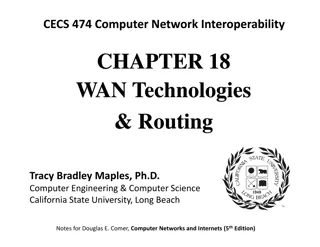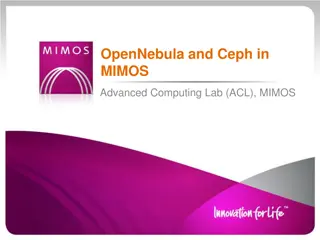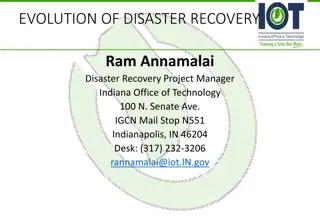Introduction to WAN Technology Overview
WANs, or Wide Area Networks, are essential for connecting geographically separated sites in businesses. They help in sharing data, accessing information remotely, and supporting productivity. This content discusses the purpose of WANs in various scenarios, such as connecting regional offices, enabling communication for mobile workers, and facilitating research for students. It also explores the evolving network needs of companies and provides examples of WAN implementation in small office environments like SPAN Engineering. The content highlights the role of WANs in supporting businesses' communication and operational requirements.
Download Presentation

Please find below an Image/Link to download the presentation.
The content on the website is provided AS IS for your information and personal use only. It may not be sold, licensed, or shared on other websites without obtaining consent from the author.If you encounter any issues during the download, it is possible that the publisher has removed the file from their server.
You are allowed to download the files provided on this website for personal or commercial use, subject to the condition that they are used lawfully. All files are the property of their respective owners.
The content on the website is provided AS IS for your information and personal use only. It may not be sold, licensed, or shared on other websites without obtaining consent from the author.
E N D
Presentation Transcript
Lecture 3: Introduction to WAN WAN Technology Overview
Purpose of WANs Why Choose a WAN? Operates beyond the geographic scope of a LAN Used to interconnect the enterprise LAN to remote LANs in branch sites and telecommuter sites Owned by a service provider Organization must pay a fee to use the provider s services to connect sites
Purpose of WANs Are WANs Necessary? Businesses require communication among geographically separated sites. Examples include: Regional or branch offices must be able to communicate and share data. Organizations must share information with other customer organizations. Mobile workers must access information that resides on corporate networks. Home computer users must send and receive data across increasingly larger distances. Examples include: Consumers communicate over the Internet with banks, stores, and a variety of providers of goods and services. Students do research by accessing library indexes and publications located in other parts of the country and in other parts of the world.
Purpose of WANs Evolving Networks Companies expect their networks to perform optimally and to be able to deliver an ever increasing array of services and applications to support productivity and profitability. SPAN Engineering example used in the curriculum
Purpose of WANs Small Office SPAN Engineering Environmental Consulting Firm Been in business for four years, has grown to include 15 employees: six engineers, four computer-aided drawing (CAD) designers, a receptionist, two senior partners, and two office assistants Uses a single LAN to share information between computers, and to share peripherals, such as a printer, a large-scale plotter, and fax equipment Upgraded LAN to provide inexpensive VoIP service to save on the costs of separate phone lines for their employees Connection to the Internet is through a common broadband service called DSL Uses support services purchased from the DSL provider Uses a hosting service rather than purchasing and operating its own FTP and email servers
Purpose of WANs Campus Network SPAN Engineering Environmental Consulting Firm Five years later has grown rapidly. Contracted to design and implement a full-sized waste conversion facility. Won other projects in neighboring municipalities and in other parts of the country. Hired more staff and leased more office space with several hundred employees, organized itself into functional departments. Network now consists of several subnetworks, each devoted to a different department. Multiple LANs are joined to create a company-wide network or campus, which spans several floors of the building.
Purpose of WANs Small Office Campus Network
Purpose of WANs Branch Networks Another six years later, SPAN Engineering demand for its services has skyrocketed. To manage those projects, the company has opened small branch offices closer to the project sites. SPAN Engineering now has a data center, which houses the various databases and servers of the company. They must now implement a WAN. For its branch offices that are in nearby cities, the company decides to use private dedicated lines through their local service provider. For those offices that are located in other countries, the Internet is an attractive WAN connection option. Although connecting offices through the Internet is economical, it introduces security and privacy issues that the IT team must address.
Purpose of WANs Branch Networks (cont.)
Purpose of WANs Distributed Networks SPAN Engineering has now been in business for 20 years and has grown to thousands of employees distributed in offices worldwide. Cost of the network and its related services is a big expense. Looking to provide the best network services at the lowest cost. Encouraging teleworking and virtual teams, web-based applications are being used to increase productivity and reduce costs. Site-to-site and remote access Virtual Private Networks (VPNs) enable the company to use the Internet to connect easily and securely with employees and facilities around the world.
Purpose of WANs Distributed Networks (cont.) Network requirements can change dramatically as the company grows. Distributing employees saves costs in many ways, but it puts increased demands on the network. Network must be able to adapt and grow as the company changes. Network designers and administrators meet these challenges by carefully choosing network technologies, protocols, and service providers, and by optimizing their networks.
Purpose of WANs Distributed Networks (cont.)
WAN Operations WANs in the OSI Model WAN access standards typically describe both physical layer delivery methods and data link layer requirements, including physical addressing, flow control, and encapsulation.
Whats Internet Mobile network Global ISP millions of connected computing devices: hosts = end systems wireless laptop cellular handheld access points Packet switches: forward packets (chunks of data) routers and switches PC server Home network Regional ISP communication links fiber, copper, radio, satellite Institutional network wired links router protocols control sending, receiving of messages e.g., TCP, IP, HTTP, Ethernet 14
Whats Internet? Simply is a network of networks or Interconnected ISPs The Internet is a global system of interconnected computer networks that use the standard Internet protocol suite (TCP/IP) to serve several billion users worldwide. It is a network of networks that consists of millions of private, public, academic, business, and government networks, of local to global scope, that are linked by a broad array of electronic, wireless, and optical networking technologies. The Internet carries an extensive range of information resources and services, such as the inter-linked hypertext documents of the World infrastructure to support email, etc. Wide Web (WWW), the 15
A closer look at network structure: network edge: hosts: clients and servers servers often in data centers mobile network global ISP home network access networks, physical media: wired, wireless communication links regional ISP network core: interconnected routers network of networks institutional network 16
Core Networks Tier 1 ISP 17
Internet Structure: Network of Networks A packet passes through many networks! local ISP local ISP Tier 3 ISP local ISP local ISP Tier-2 ISP Tier-2 ISP Tier 1 ISP Tier 1 ISP Tier 1 ISP Tier-2 ISP local ISP Tier-2 ISP Tier-2 ISP local ISP local ISP local ISP 18























